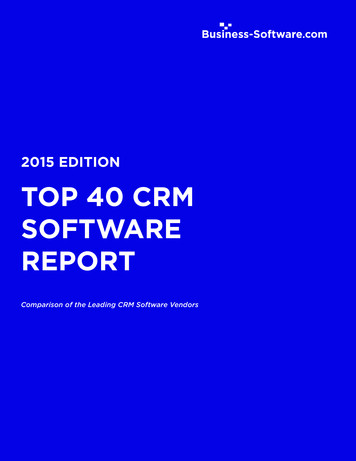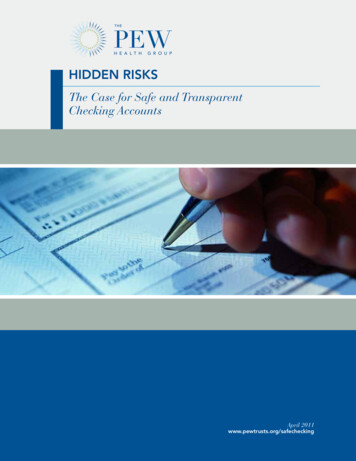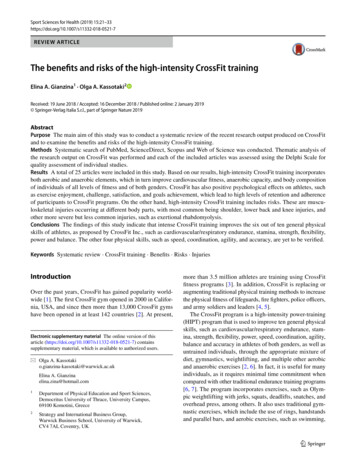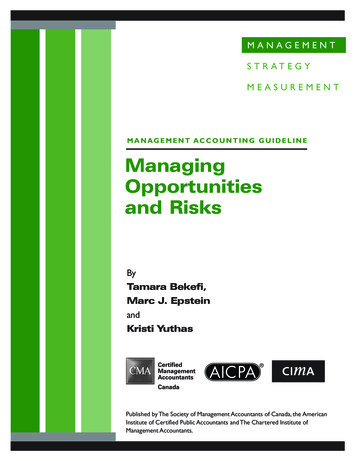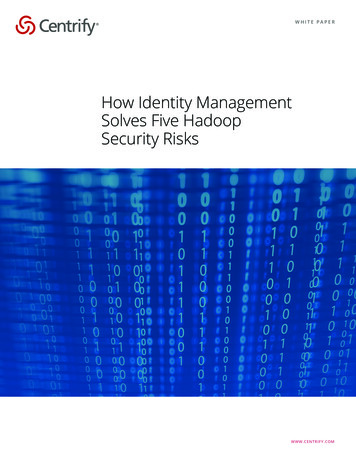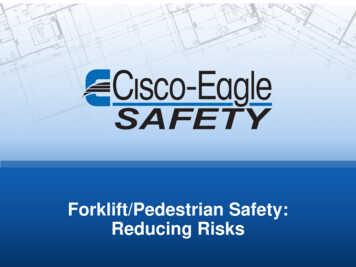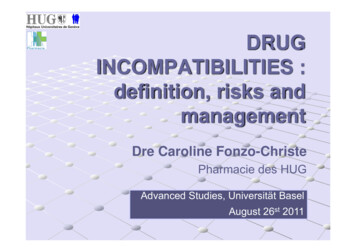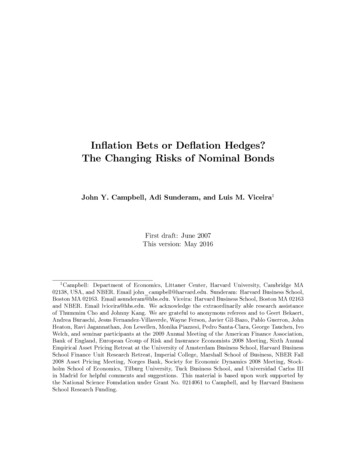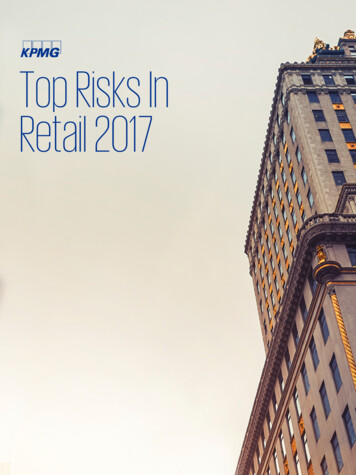
Transcription
Top Risks InRetail 2017
Top Retail risks for 2017RiskCompetitionDescriptionPoints to ConsiderIntense competition on a national and internationallevel both in the U.S. and abroad.Diverse retailers offer the same or similarmerchandise and compete on the basis of price,quality, or speed to market.Competitors may have greater resources or evolvedbusiness models that provide a better shoppingexperience.Cost of entry into the market at all time low, while alarge number of niche players driving change. Customer is the new point-of-sale. For today'sconnected consumer, the shopping 'experience' canbe endless.About half of consumers actually enter retail stores.Shopping experiences that are meaningful,memorable, shareable, and personalized maintaintraffic.Incorporating technology into a brand personathrough influencer marketing can be a powerful tool indriving customer habits. Marketing must be relevant tothe product offering and meet consumer needs.Brand building on the retail front has become a teamsport for many firms that are generating significantresults via partnerships that deliver competitiveadvantages. GeneralEconomicConditionsGDP growth below expectations for first half of year,primarily due to impact of oil and gas sectors.Expecting to see slow but steady growth in the USeconomy over next 2-3 yearsRetail sales annual growth has decreased every yearover the last 5 years from 7% to 2.2%.70 consecutive months of jobs growth in US.Pressure for transformation is increasing.Rise of “platform” companies in unexpected areas(Google in healthcare etc.).Interest rates expected to stay the same until Dec.Conditions impacting consumers perception and economicconditions include: Impact of contentious Presidential election Regional unemployment levels Government gridlock Impact of government spending, and tax policy Minimum wage increasesImpact of changing economy (manufacturing based has moved toservice and technology based)Brand andReputationRetailers run the risk that one innocuouspost/video/comment from any angle (Board, customer,associate, management) could trigger a significantbrand protection situation which impacts sales orcustomer perspective. High volume of consumer touch points.Rapid expansion of social media.Years to build reputation and seconds to destroy.Can happen anywhere in chain. Change fails when programs are exclusively focusedon the technical excellence of the team.Probability of failure increases if people andorganizational resistance to change is not proactivelymanaged.Root cause of transformation issues: Project management problems (32%) Failure to define objectives (17%) Lack of communication (20%) Inexperience in scope and complexity (17%) Technical Issues (14%)ConsumerTrends /PreferencesTransformationRisk Pricing and promotional strategy (new normal?)Physical and virtual location arbitrageBusiness model differences based on culture, retail subchannel and historyImpact of mobile commerce / social mediaGlobalized retail markets and foreign retail entry into U.S.Cost of delivery expectationsImpact and growth of a more socially conscious shopperPop up stores and lower cost of concept and entryNext “big “ thing (VR etc.)Consumer products & retail comprise roughly 20% of the USeconomyNearly 40% of US households have Amazon Prime40% of men and 33% of women aged 18 to 34 would buyeverything online if they could95% of Millennials want to build meaningful interactions withbrands on social mediaAmazon is #1 in customer satisfaction among both online andstore-based retailersMost retailers react to situations as they happen. Need toproactively have plans in placeTypes of brand damage Long / slow / denial – Sears Immediate – Target Cyber Continuous hits -- ChipotleIncrease of disaster recovery plans for Brand situationsMonitoring of consumer sentiment 2016 KPMG LLP, a Delaware limited liability partnership and the U.S. member firm of the KPMG network of independent member firmsaffiliated with KPMG International Cooperative (“KPMG International”), a Swiss entity. All rights reserved.2
Top Retail risks for 2017RiskSecurity ofCustomer ologyDisruption andChangeAttract &RetainPersonnelDescriptionRisk of security breaches of business and customerdata through cyber-attacks from hackers andsophisticated organizations.Gaps in control structure due to reliance on 3rdparty vendors.Risk of significant business impact of key systemsnot being available (websites, core operatingsystems, e-mail etc. through methods such asDenial of Service attacks and others).Points to Consider Rise in regulations around cyber complianceLeadership and governanceHuman factorsInformation risk managementCybersecurity, business continuity and crisis managementOperations and technologyLegal and complianceBack up and supportIncreased regulation pertaining to operations,product liability, competition, consumer protection,price controls social and environmentalconsiderations.More proactive adherence to compliance will benecessary.Litigation against U.S. retailers is rising (i.e. classactions).Litigation areas are extensive and require strongbusiness controls and experienced legaldepartments. New revenue recognition and lease accounting rulesNew ISO 37001 Anti-Bribery Management System standard willbe published and available for certificationFCPA/UK Bribery ActHealthcare reform impactLabor compliance (Min wage, FLSA, Minors, California)ADA impact on OmnichannelCorporate social responsibility and controls at partnersSOX and PCAOB changesClass action lawsuits due to performance, compliance breach orotherInternational compliance for product safety, labor, pricing etc.Significant risk exists in the management of rapidlychanging IT infrastructure due to the growingimportance of technology and strategic shift inspeed of technology change.The temptation to continuously, incrementallyimprove legacy systems - beyond what is trulybroken or required by regulation - is ongoing andoften results in adding “technical debt” to alreadyarcane infrastructure.Aligning inventory, pricing, and customer systems isa must to deliver a seamless customer experience. Loss of critical resources that will impact thebusiness’ ability to deliver customer service,business results and stakeholder expectations.Rapid personnel changes at executive levels lead togaps in ability to define and execute strategy.Taxation Temp workers hired earlier this seasonCompensation and benefitsWork/life balanceClearly defined job descriptions and paths to promotionSuccession planning and bench strengthCorporate culture and expectations vs. “connected culture”Talent managementTraining and development best practices Global tax impacts of new business structures giving balancedconsideration to tax efficiency and tax riskState and local tax effects of new business strategies andstructures, including company expansion into additional localitiesImplement the right tax structuring to maximize the long-termvalue of global growthWeigh the potential tax risks and benefits of contemplatedtransactions – including transfer pricing, the new BEPS guidance,and local country tax requirementsTransform the internal tax function to support an expandedbusiness footprintConsider state and city economic business incentivesEnsure tax and human resource departments are aligned whenmoving global talent A large percentage of retailers don’t realize the fullpotential of their transformation efforts due to a lackof clarity about the role of tax and how it fits in.Failure to include tax at the table duringtransformational efforts diminishes the effectivenessand efficiency of the transformation agenda in anyretailer, regardless of the size or scope of theorganization or its transformation.Updating POS to support transactions through all mediumsMobile POS/re-platform of e-commerce and growth of useTechnology framework dilemma (ERP v best of breed)Explosion of cloud based solutionsExpanded software licensing reachTechnology migration towards connected customer (loyaltyprograms linked with sales and social media)Rapid evolution of consumer technology“Best of Breed” vs. Integrated Enterprise toolsEnsure technology strategy / spend support the overall businessstrategy 2016 KPMG LLP, a Delaware limited liability partnership and the U.S. member firm of the KPMG network of independent member firmsaffiliated with KPMG International Cooperative (“KPMG International”), a Swiss entity. All rights reserved.3
Top Retail risks for 2017RiskOmni Channeland 21st CenturyRetailingDescription Customers gravitate to retailers that provide the bestand most consistent multifaceted experience based ontheir quality/value perspectiveIt’s not yet clear what the next trigger point fortransformation in retail will be, however, it will occur inthe next 5-10 years (VR, self driving cars, embeddedcommunication, etc.)Pricing Consumer technology again evolving rapidlyCustomer engagement or conversation instead oftransaction (one view of customer)Updating of infrastructure and merchandising systemsEstablishing enterprise inventory (one view of inventory)Expanding mobile purchasingStrategic revision of critical areas for a retailer: channelmix management, brand experience delivery,merchandising, communication, personalization ofshopping, communication, offers, transaction processing,inventory management, logistics, forecasting, incentivealignment and customer profiling Customers expectations on pricing are changing.Retailers often go all out featuring the ‘lowest prices’ or‘best bargains.’ While the discounting pulls in newcustomers, it also erodes margins.Smart retailers focus less on deep discounts and moreon customer experience. They also turn to dynamic ortime-based pricing - sophisticated algorithms andcomputing programs to monitor real-time prices onitems sold by competitorsData and InsightPoints to ConsiderBig data has long been touted as the next bigtransformation point, however, this has not yetoccurred in mainstream retail.While retailers capture a large amount of data oncustomers, purchases, and trends, few have leveragedthis to be able to form valuable insight that gives theman edge.The issues are exacerbated by recent implementationof omnichannel fulfillment strategies without adequatethought on the data and reporting needs that come outof new processesData overload has become a problem in retailInternationalBusiness RiskAnalytics and IT platforms that tap into ebbs and peaks ofconsumer activity help retailers make informed and timelydecisions regarding competitive pricing strategies muchbetter than tradition or existing policies: Amazon uses dynamic pricing and conducts pricechanges on average every 10 minutes Walmart uses dynamic pricing to make over50,000 price changes monthlyChallenges include: the disconnect between localized store pricing and webbased pricing, The direct relationship between Inventory managementpractices and pricing Competitive movement Undercutting from suppliers with retail outlets Impact of “total price consideration” for a customer(includes cost of product, cost of delivery (free shipping),cost of return, ease of return and previous experience) Differences in cultural and economic conditionsbetween the U.S. and other countries can formsignificant barriers to entry for U.S. retailers.Lack of understanding of country nuances whereretailers are expanding can quickly result in significantcosts and divert resources from other strategicinitiatives. What is your data strategy? How does this tie in with youroverall strategy?How trusted is the data that comes out of yourorganization? How do you know?What data governance steps have you put in place?Does your whole organization have consistent basedefinitions that everyone follows (Sales, profit, margin)How much time does your team spend vetting data andreports in stead of analyzing them?What are the “insight” levers that within trigger directionalchange in your organization? If you don’t have them, whynot?Disruptions caused by changes in international, social,political, legal and economic conditionsImposition of barriers on tradeCurrency fluctuationsAdapting to local customs and cultureUnexpected changes in regulatory requirementsPolitical instability and terrorist attacksChanges in diplomatic and trade relationshipsDelays in the delivery of cargo due to securityconsiderations or insolvencyLack of suitable location and price of real estate 2016 KPMG LLP, a Delaware limited liability partnership and the U.S. member firm of the KPMG network of independent member firmsaffiliated with KPMG International Cooperative (“KPMG International”), a Swiss entity. All rights reserved.4
kpmg.com/socialmediaThe information contained herein is of a general nature and is not intended to address thecircumstances of any particular individual or entity. Although we endeavor to provide accurate andtimely information, there can be no guarantee that such information is accurate as of the date it isreceived or that it will continue to be accurate in the future. No one should act on such informationwithout appropriate professional advice after a thorough examination of the particular situation. 2016 KPMG LLP, a Delaware limited liability partnership and the U.S. member firm of the KPMGnetwork of independent member firms affiliated with KPMG International Cooperative (“KPMGInternational”), a Swiss entity. All rights reserved.The KPMG name and logo are registered trademarks or trademarks of KPMG International.
Gaps in control structure due to reliance on 3rd party vendors. Risk of significant business impact of key systems not being available (websites, core operating systems, e -mail etc. through methods such as Denial of Service attacks and others). Rise in regulations around cyber compliance Leadership and governance Human factors Information risk management Cybersecurity .
